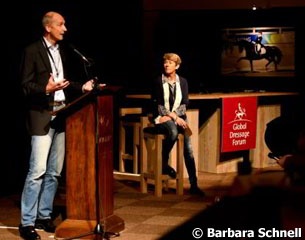
It may only have sounded mildly interesting in the program announcement, but Dirk Willem Rosie's hommage to seven of the world's best dressage horses turned out to be one of the great highlights of the 2015 Global Dressage Forum held at Bartels' Academy in Hooge Mierde, The Netherlands, on 26 - 27 October 2015.
An online vote had determined Ahlerich, Rembrandt, Matador, Bonfire & Salinero, Totilas and Valegro to be the horses that would be remembered at the forum. While Rosie drew upon his knowledge as a sports journalist and breeding expert to introduce these horses with their objective strengths and weaknesses, it was the people connected with these horses who made this a highly personal and heartwarming presentation. Ruth Klimke and Ahlerich's groom Claudia Rosner, Totilas' breeder Jan Schuil, Matador's rider Kyra Kyrklund or Valegro's owner Roly Luard contributed the memories and anecdotes that gave the video sequences a third dimension, while Rosie analyzed the bloodlines and physical characteristics that have made these horses born winners – or champions against all odds.
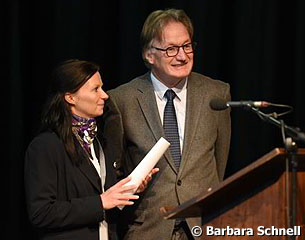 How do I recognize the makings of a good dressage horse? How do I keep him happy in our daily training? How do I feed him best according to his needs? But also: Where is high-performance dressage headed? Will it be able to keep its Olympic status? How can we improve the quality of the judging to make the sport fairer and more transparent? This mixture of highly individual and more global, technical issues made the 2015 Forum an interesting place to watch and learn … and to wonder.
How do I recognize the makings of a good dressage horse? How do I keep him happy in our daily training? How do I feed him best according to his needs? But also: Where is high-performance dressage headed? Will it be able to keep its Olympic status? How can we improve the quality of the judging to make the sport fairer and more transparent? This mixture of highly individual and more global, technical issues made the 2015 Forum an interesting place to watch and learn … and to wonder.
Frank Kemperman, chairman of the Dressage Committee, introduced Carina Mayer, interim Head of the Dressage Department. They reported the latest developments -- a Degree of Difficulty marking system for the freestyle will now become mandatory in the 2016 World Cup qualifiers – as well as propositions for 2016, most notably that a rider who goes on a wrong course during a test shall automatically lose three per cent of his end result, thus being punished much harder for a temporary glitch than a rider with an underlying problem that results in, say, incorrect pirouettes.
After O-Judge Katrina Wüst introduced her ideas to improve technical freestyle judging at the GdF two years ago, Wayne Channon now presented a concept that tackles the other half of judging the format that is most popular with the spectators: While music will always remain a highly subjective matter, any judge should still be able to perceive if a rider's chosen music matches the rhythms of his horse, if the choreography uses the music to mark, for example, flying changes or pirouettes, and if the transitions are correct. So Channon presented an evaluation sheet that makes it easier for the judges to focus on the things that are measurable when judging the artistic part of a freestyle.
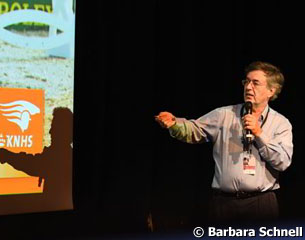 Likewise Maarten van der Heijden, Sports Director of the Dutch Federation, and dressage analyst David Stickland put the spotlight on a new database that can help judges to put their work into perspective, and federations to communicate better with the judges. A huge data pool shows each judge exactly how often he agrees or disagrees with his colleagues. When constant disagreement becomes so obvious as to be perceived as a problem, the federation will try to evaluate where it stems from and, if necessary, provide the judge with a personal coach who will work with him. The FEI representatives listened to this with pricked ears – the system is already being used in the Netherlands and may prove a useful tool to help prevent future judging disasters.
Likewise Maarten van der Heijden, Sports Director of the Dutch Federation, and dressage analyst David Stickland put the spotlight on a new database that can help judges to put their work into perspective, and federations to communicate better with the judges. A huge data pool shows each judge exactly how often he agrees or disagrees with his colleagues. When constant disagreement becomes so obvious as to be perceived as a problem, the federation will try to evaluate where it stems from and, if necessary, provide the judge with a personal coach who will work with him. The FEI representatives listened to this with pricked ears – the system is already being used in the Netherlands and may prove a useful tool to help prevent future judging disasters.
From the future back to tradition: With a young stallion at the end of breeding season and an older horse that has made it to S-level despite an anatomical irregularity, Paul Fielder showed how much valuable work you can do without putting a saddle on the horse. In order to promote confidence and rideability in his horses, he works them on the long reins. His demonstration was greeted with great applause from many Olympic athletes who consider this kind of work and art form that should be taught much more universally.
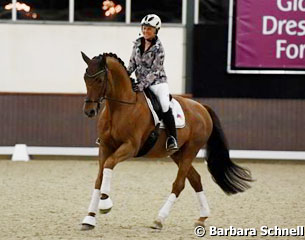 German Grand Prix Rider Uta Gräf knows all about the value of teaching a horse on the long reins – that's how her husband Stefan Schneider prepares all her horses for her. With three horses she demonstrated how much this painstaking and patient investment in rideability can achieve: Helios, a nine-year old gelding, isn't a horse one would expect in a top athlete's yard, and Uta herself describes him as a „normal“ horse. But: „If you have a nice horse that's healthy and wants to go, you can get much further that you think.“ Riding some canter work on a circle line with a varying diameter, she interchanges normal canter with stretches of travers in order to improve the canter and help the horse to carry himself.
German Grand Prix Rider Uta Gräf knows all about the value of teaching a horse on the long reins – that's how her husband Stefan Schneider prepares all her horses for her. With three horses she demonstrated how much this painstaking and patient investment in rideability can achieve: Helios, a nine-year old gelding, isn't a horse one would expect in a top athlete's yard, and Uta herself describes him as a „normal“ horse. But: „If you have a nice horse that's healthy and wants to go, you can get much further that you think.“ Riding some canter work on a circle line with a varying diameter, she interchanges normal canter with stretches of travers in order to improve the canter and help the horse to carry himself.
The second horse, Lawrence, already competes in Grand Prix classes and he „constantly anticipates things, so here the challenge for me was to get him to listen to my aids. So I basically do the same excercise as with Helios, but with him, I don't do it to activate the hind leg but to say 'stay here'.“
Damon Jerome „is a horse who has everything. I didn't have to teach him – he taught me. He's very secure in his rhythm, so all I have to do here is to keep him busy with a high level of variation, to surprise him with new things every few meters so that he stays on my aids.“ Uta Gräf wants her horses to listen to her aids – but her attention for them is just as impressive.
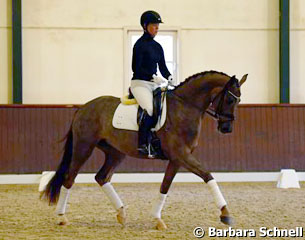 In a similar vein, Wolfram Wittig also gave a demonstration of the improvement of rideability, showing two tremendous youngsters by Boston and Bellissimo, ridden by his trainee Kira Wulferding, and a home-bred gelding, Brioni, ridden by his wife Brigitte. In the past three decades, the Wittigs have bred almost forty horses that compete at the highest level, and their string of 13 full sisters and brothers (over half of which are Grand Prix horses) by Breitling W is legendary. Wittig looks for rhythm and balance in a horse -- one reason why he loves to breed horses himself because „the first and best place to judge a horse's ability to carry itself is in the field. If it can't handle itself there, how is it supposed to cope under the rider?“ Rhythm and balance were also the key element of his presentation. „I think it's unavoidable that in our daily work, a young horse will get behind the vertical now and again. It's similar strides that I'm aiming for, in the baby steps as well as the later collected work. If I can get that, the horse will start to carry itself, find balance and the right posture. And that, after all, is what we want – that a horse's posture is the result of our training, not an artificial trick that it shows only in competition.“
In a similar vein, Wolfram Wittig also gave a demonstration of the improvement of rideability, showing two tremendous youngsters by Boston and Bellissimo, ridden by his trainee Kira Wulferding, and a home-bred gelding, Brioni, ridden by his wife Brigitte. In the past three decades, the Wittigs have bred almost forty horses that compete at the highest level, and their string of 13 full sisters and brothers (over half of which are Grand Prix horses) by Breitling W is legendary. Wittig looks for rhythm and balance in a horse -- one reason why he loves to breed horses himself because „the first and best place to judge a horse's ability to carry itself is in the field. If it can't handle itself there, how is it supposed to cope under the rider?“ Rhythm and balance were also the key element of his presentation. „I think it's unavoidable that in our daily work, a young horse will get behind the vertical now and again. It's similar strides that I'm aiming for, in the baby steps as well as the later collected work. If I can get that, the horse will start to carry itself, find balance and the right posture. And that, after all, is what we want – that a horse's posture is the result of our training, not an artificial trick that it shows only in competition.“
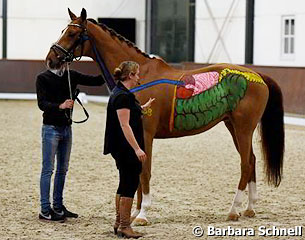 British vet Chloe Casalis de Pury touched on another crucial aspect of horse welfare: nutrition. Her somewhat rushed presentation still left the audience with a clear impression, thanks to the two painted horses she had brought. One showed the intestinal system – it needs lots of fiber (the daily amount she recommends for a 600 kilo warmblood horse is fourteen kilos of hay) --, the other the muscular system, which needs supplementation in order to work at competition level. The high amounts of starch contained in conventional feeds contradict the needs of the intestines of a grazing animal, though, so Casalis urged the audience to be aware of the workings of a horse, and to rethink their feeding habits.
British vet Chloe Casalis de Pury touched on another crucial aspect of horse welfare: nutrition. Her somewhat rushed presentation still left the audience with a clear impression, thanks to the two painted horses she had brought. One showed the intestinal system – it needs lots of fiber (the daily amount she recommends for a 600 kilo warmblood horse is fourteen kilos of hay) --, the other the muscular system, which needs supplementation in order to work at competition level. The high amounts of starch contained in conventional feeds contradict the needs of the intestines of a grazing animal, though, so Casalis urged the audience to be aware of the workings of a horse, and to rethink their feeding habits.
Tradition met the future at this year's Global Dressage Forum as the FEI's future attempts to turn dressage into a circus in the hopes of keeping it Olympic were revealed, alongside more interesting developments in the judging of the freestyle. Good (traditional) dressage was shown by Uta Gräf and Wolfram Wittig, whereas British trainer Paul Fielder explained with his long lining demonstration that dressage does not necessarily need to happen in the saddle. Chloe Casalis, though slightly crammed in the corner, pretty much summed it up with her "be sensible, people" statement.
Text and Photos © Barbara Schnell
Related Links
Global Dressage Forum to Move to Hof Kasselmann in 2016
Highlights of the 2015 Global Dressage Forum